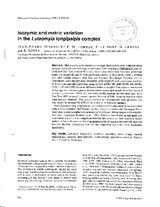Mostrar el registro sencillo del ítem
Isozymic and metric variation in the Lutzomyia longipalpis complex
| dc.contributor.author | Dujardin, Jean-Pierre | |
| dc.contributor.author | Torrez, EM | |
| dc.contributor.author | Le Pont, F | |
| dc.contributor.author | Hervas, D | |
| dc.contributor.author | Sossa, D | |
| dc.date.accessioned | 2018-06-27T14:21:56Z | |
| dc.date.available | 2018-06-27T14:21:56Z | |
| dc.date.issued | 1997 | |
| dc.identifier.uri | http://repositorio.umsa.bo/xmlui/handle/123456789/16784 | |
| dc.description.abstract | Abstract. Male Lutzomyia longipalpis of two types from Bolivia were compared using isozyme electrophoresis and wing morphometry. One sample (ex Chiflonkaka Cave, alt. 2800 m at Toro Toro, Charcas Province, Potosi Department) was ‘two-spot’ phenotype males (i.e. tergites III and IV with paired pale patches of pheromone glands), whereas two other locality samples (Apa Apa and Imanaco, Sud Yungas Province, La Paz Department) were one-spot male phenotype (only tergite IV with paired pale patches). Multilocus enzyme electrophoresis (using ACON, aGPD, GPI, IDH, MDH, ME, 6PGD, PGM, LAP and PEPB) found no difference between samples from adjacent hen houses at Apa Apa. Nei's standard genetic distance between one-spot samples from Apa Apa and Imanaco (5 km apart, 1500m alt.) was 0.001-0.002, whereas the two-spot males from Toro Toro (800 km away) showed a genetic distance of 0.081 from the one-spot males (Apa Apa and Imanaco). This genetic distance is commensurate with speciation, but may simply be intraspecific differentiation due to ‘isolation by distance’. For comparative wing morphometry, we included additional material of one-spot males from Bolivia (Guyabal, Sud Yungas, La Paz), Brazil, Colombia and Nicaragua. These three other country samples were assumed to be different sibling species in the complex Lutzomyia longipalpis (Lanzaro et al, 1993). Statistics were based on univariate and multivariate analysis. The comparison between size-in and size-free canonical variate analysis (CVA) indicated that the wing morphometric divergence between one-spot and two-spot Bolivian phenotypes was not size dependent and could have taxonomic significance. | es_ES |
| dc.language.iso | en | es_ES |
| dc.publisher | Medical and Veterinary Entomology | es_ES |
| dc.subject | LUTZOMYIA LONGIPALPIS | es_ES |
| dc.subject | MOSCAS DE ARENA | es_ES |
| dc.subject | ALAS DE INSECTOS | es_ES |
| dc.subject | LEISHMANIASIS VICERAL | es_ES |
| dc.subject | MORFOMETRÍA | es_ES |
| dc.subject | BOLIVIA | es_ES |
| dc.subject | BRAZIL | es_ES |
| dc.subject | COLOMBIA | es_ES |
| dc.subject | NICARAGUA | es_ES |
| dc.title | Isozymic and metric variation in the Lutzomyia longipalpis complex | es_ES |
| dc.type | Article | es_ES |

